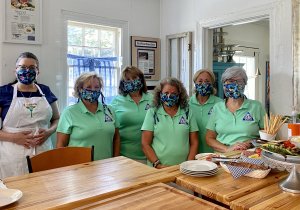October FloridAgriculture eNewsletter
 Jessica Bright McMullen is a chef who works closely with the farmers in the Tallahassee region, using seasonal, locally sourced ingredients whenever possible.
Jessica Bright McMullen is a chef who works closely with the farmers in the Tallahassee region, using seasonal, locally sourced ingredients whenever possible.
While in Tallahassee in December to attend Florida Farm Bureau Day, the Duval County Farm Bureau Women’s Leadership Committee had a chance to learn more about Jessica’s commitment to those growers, particularly those who have joined together in the Red Hills Small Farm Alliance. The committee was invited to a reception at KitchenAble Cooking School, a charming cottage at Lake Ella. Jessica, the chef and owner of KitchenAble is the daughter of Duval County Farm Bureau members Greg and Joy Tison.
Jessica’s loyalty to locally grown food is rooted in her childhood, growing up on a small farm in Ayden, North Carolina. She learned early on to appreciate the role of agriculture in our state, and she loves to share her passion for cooking with home cooks.
The name of her cooking school, KitchenAble, identifies her mission statement — enabling students to have the knowledge and culinary skills they need to prepare meals in their home kitchens. She stresses finding the best quality ingredients instead of resorting to processed or packaged foods.
After initially visiting her cooking school at Lake Ella, the Duval County Farm Bureau Women’s Leadership Committee enjoyed a private cooking class with Jessica. The menu included a welcoming antipasto of roasted vegetables, sausage, cheese and crackers, followed by a hands-on class featuring a meal of focaccia bread, a classic Italian salad, fettuccini Alfredo and torta meringata al limone (lemon meringue cake).
Jessica’s recipes incorporated fresh herbs from her garden, eggs, honey, vegetables and fruit. Throughout the cooking class, Jessica offered tips for using herbs to enhance her dishes. She offered other suggestions as well, such as using vanilla paste instead of vanilla extract for depth of flavor and sharing the secret to making really delicious coffee — using a French press and adding a pinch of salt — just to name a few.
Jessica’s passion for hosting was obvious from the time the Farm Bureau Ladies arrived. No one is a stranger in her kitchen, and it is hands-on for everyone in the class. Jessica usually has just the right music playing to accompany the meal or dish being prepared.
The committee appreciated her knack for simplifying even complicated recipes. She walked us through making homemade pasta and let us mix, cut and prepare the dough, and other dishes. Her 13-year-old daughter, Madeline, was Jessica’s right-hand helper, pitching in and lending a hand to make the day fun as well as educational.
For our private lesson, Jessica slowed down to our pace and let us enjoy the day — cooking, learning, tasting and eating, especially eating.
It was good to see a young woman who has followed her passion to own a business, doing what she loves best with the support and teamwork of her family.
One of our committee members summarized the day by saying that the camaraderie of women working together to achieve a common goal reminded her of her grandmother, mother and sisters working together in her grandma’s kitchen preparing a meal. It was a fun, informative and delicious day!
If you are interested in scheduling a private cooking class with Chef Jessica, or joining one of her open classes, she can be reached at: KitchenAble Cooking School & Catering, Cottages of Lake Ella, 1635 North Monroe Street, Tallahassee, FL 32303; (850) 264-2308.






